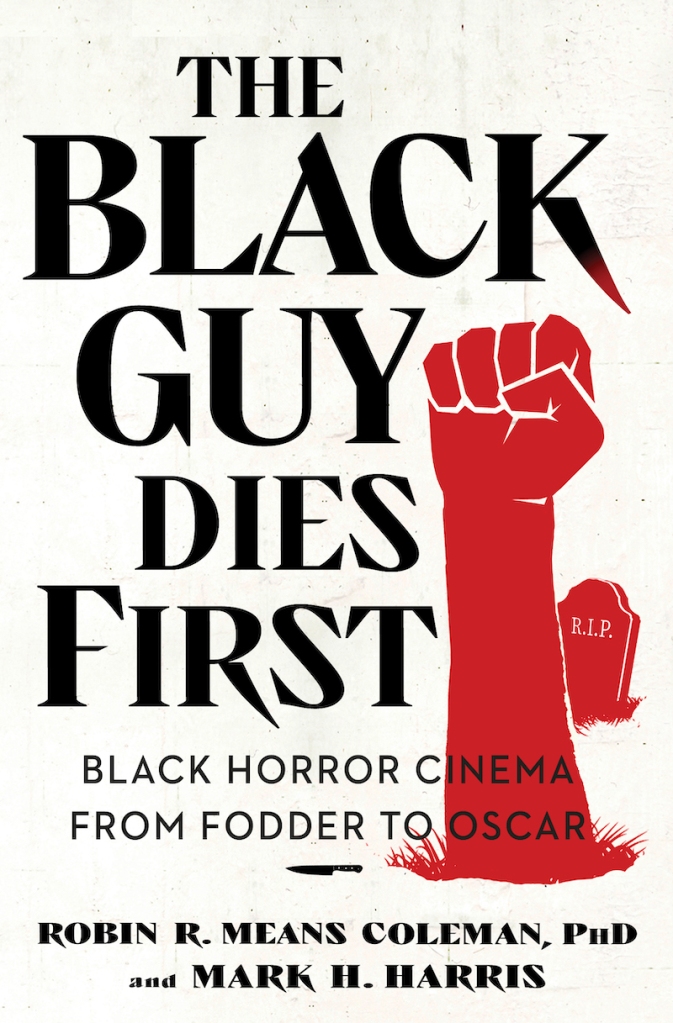
Why ‘The Black Guy Dies First’ in Horror Movies
When there is a Black principal actor in a scary movie, we all know what their fate entails. Enter Dr. Robin R. Means Coleman and vet movie critic Mark H. Harris, who have made it their duty to hunt down the controversial cultural schisms in horror cinema from 1968 on in their teamed text The Black Guy Dies First (out Feb 7). Their prolific 2019 documentary Horror Noire is their first brainchild. Similar to the doc, their second joint dissects the same scary racial truths of early thrillers to modern blood-smearing tentpoles with encyclopedic cognition. Both Coleman and Harris value fear flicks as much as they deadpan when watching short-lived Black characters wasted on the silver screen. TBGDF chronologizes Black roles and sees these Black writers critique and quip over this unspoken celluloid condition that has perturbed Black moviegoers since the genre’s origin.
Bearing the heaviness of hundreds of fictional Black deaths in motion pictures, Coleman and Harris study the implications of race in the 20th century to the titular trope. Firstly, TBGDF orients the reader with sanguinity by displaying the highest-grossing Black horror films of all time. Even if Black protagonists die in the film’s final scenes — Will Smith in I am Legend (2007, #1) or Lupita Nyong’o in Us (2019, #3) — Coleman and Harris record valiant demises and the diversifying forces that have created a gateway for the new wave of Black horror filmmaking auteurs. The aftershocks of Jordan Peele’s Get Out unlocked the corridor for more Black voices to be seen and heard behind the camera.
Coleman eulogizes with a sharp pen how many deaths Black actors have experienced in their long-spanning careers. Samuel L. Jackson has died a shocking 8 times, playing roles from villainous idols to conniving crooks. Candyman (1992) actor Tony Todd takes the cake (or knife) with 24 deaths, reinforcing the norm of Black performers standing in white director’s cinematic crosshairs. The Black Guy Dies First facetiously notes how greatly the Black on-screen legacy has developed from the victimized players in horror classics: “Unlike ‘The Black Guy,’ Black horror has managed to not only survive but thrive.”
Rewinding all the way back to the creation of black-and-white cinema, Black character roles were exclusively offered to those actors who wore blackface, played ancillary stereotypical characters in “race films,” or were named Sidney Poitier. Black parts were few and far between, so these creatives were jumping at the chance of being cast in a cameo performance or graphic fatal scene, giving way to the birth of the Black guy dies first trope in Spider Baby (1967) and Night of the Living Dead (1968). In Spider Baby, directed by Jack Hill (Coffy, Foxy Brown), comedy actor Mantan Moreland acts as the happy-go-lucky messenger who lives for five minutes before he is slashed to death. This is the first numbing account of Black death in horror on the big screen played out to the masses, projecting the prejudiced social context and conversations concerning race off-screen and on.
The Black Guy Dies First satirically scrutinizes how Black livelihood is perceived as entertainment “fodder” for spectators in the advent of Hollywood horror. As the protagonist Ben in Night of the Living Dead (1968), Duane Jones unveiled a distinct facet of pre-conditioned Black martyrdom. The brave leader fights off a hoard of flesh-eating zombies as the last-standing character — until, white “rescuers” step onto the grounds of the wrecked rural house searching for any traces of life, confusing survivor Ben for a zombie and opening gunfire on him. The filmmaker of Night, George A. Romero, is the earliest mind to imply a “woke horror” angle. But, with all of his white castmates dead, his character serves no more purpose when the “rescuers” arrive, alluding to another offshoot of this dangerous, racially-contrived archetype outlined in TBGDF: the heroic, sacrificial Black guy.
In the ’70s, horror became less popular (except for the intro of Blacula), which ushered in the blaxploitation era. With larger-than-life afros, corny catchphrases and intense sexuality, our “culture” (or what was seemingly meant to represent us) was being sold cinematically to viewers. Coleman and Harris indicate this era of cinema as “offensive,” but it was the first time you saw fully Black-populated theaters. The text divulges that afro picks were sold in concession stands to illuminate the film industry’s change to be for the culture.
As researchers, Harris and Coleman explicate the many Black character cliches in modern horror that we were all conditioned to live with and love. There are remarks written of the finger-snapping (“Yesss girl!!!) Black female sidekick or the (“Ah, hell no, I ain’t going in there!”) Black male gangsta archetype, punctuating satire as the new mode for entertainment. The Black Guy Dies First casts the 1980s and ‘90s as a stage for “urban” Black characters to exist. Coleman and Harris claim rap music and watershed news coverage of gang violence in the Reagan-era U.S. is the impetus of Black “urban” horror films.
The 21st century pushes the envelope of comedy in Black horror with the Wayans brother’s franchise Scary Movie (2000). Instead of acrimony from watching another Black man down, these films reverse the brunt of the joke and poke fun at it. Coleman recalls the meta scene where Brenda (Regina Hall) is killed by white moviegoers for trying to save an on-screen Black character’s life. The first Scary Movie illuminates the theory that even the white spectators aligned to early horror filmmaking’s conditioning. They needed to live out their twisted fantasies of seeing a Black figure’s death (even if they had to do it themselves).
Tananarive Due, a Black author and educator, proclaims in The Black Guy Dies First, “Black History is Black horror.” Today, the award-winning successes of the “woke horror” subgenre established by Black artists have paved the way for a promising future. The Black analysts of TBGDF point to Get Out (2017) for changing its final scene to reflect a need for racial atonement. Originally, Peele wrote the last scene as Chris (Daniel Kaluuya) ending up arrested and behind bars. With the uptick in police brutality, and after screen-testing with audiences, Peele altered the script in order for the story to have a positive ending for the Black protagonist.
The psychological-horror genre continues to expand with films like Till (2022), which was helmed by Chinonye Chukwu, a Black female director who broke barriers as the first to win the Sundance Film Festival’s Grand Jury Prize. Later this year, on Juneteenth, Black filmmakers Tim Story and Dewayne Perkins’ The Blackening will arrive in theaters. The comedy-horror film subverts the Black guy dies first slasher cliche by creating a satirical narrative where an all-Black friend group is trapped in a cabin in the woods with an anti-Black killer on the loose. Who will fictionally die at the hands of a Black writer’s room, cast, and director? That is the fun of horror: none of us will ever know, especially with banal racial stereotypes being played out. The Black Guy Dies First is ultimately a historical work of indelible research, reminding readers to not forget that the horror genre is a symbolic reflection of how much the art of cinema is willing to transform with society.



